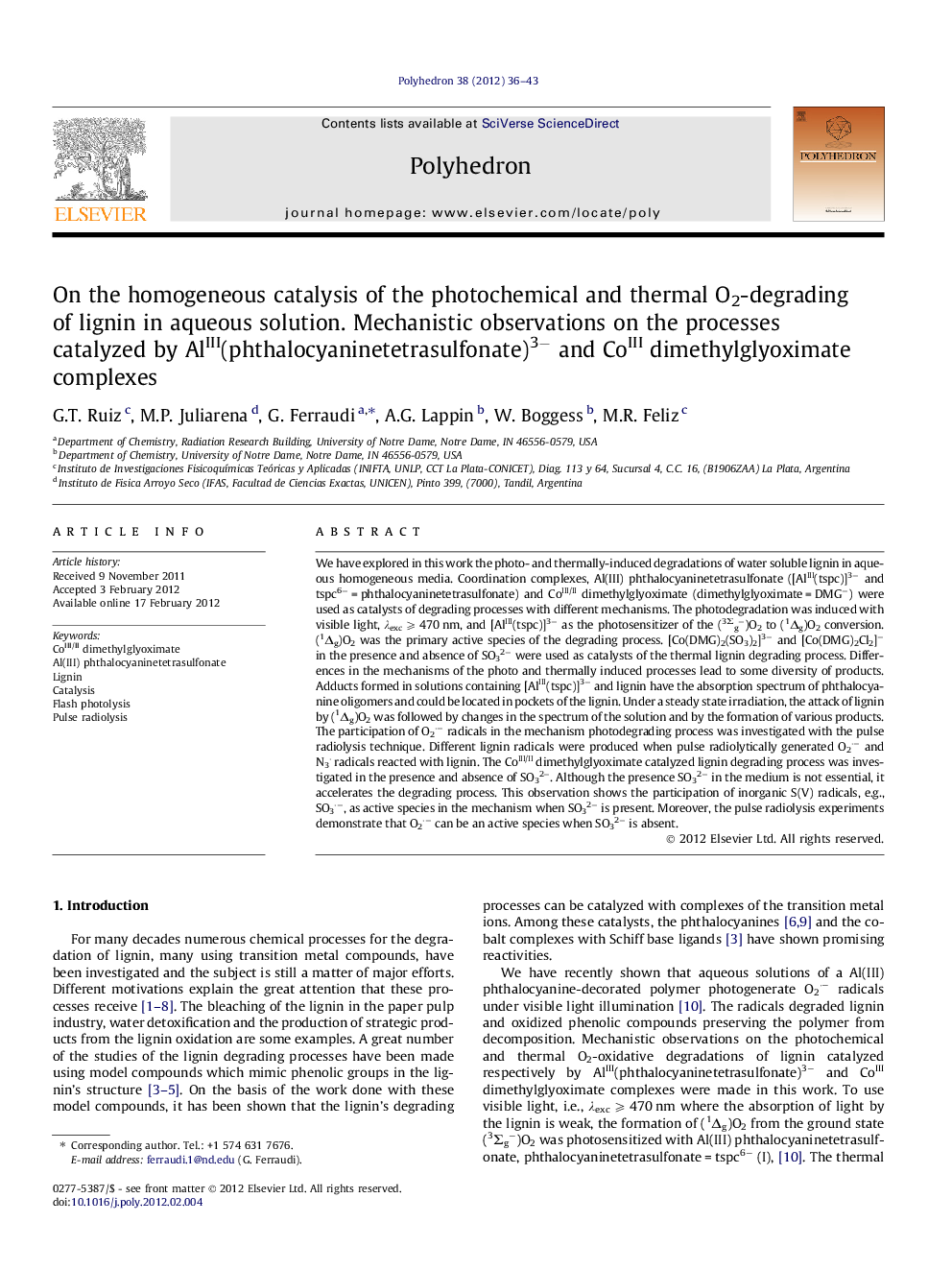| Article ID | Journal | Published Year | Pages | File Type |
|---|---|---|---|---|
| 1337655 | Polyhedron | 2012 | 8 Pages |
We have explored in this work the photo- and thermally-induced degradations of water soluble lignin in aqueous homogeneous media. Coordination complexes, Al(III) phthalocyaninetetrasulfonate ([AlIII(tspc)]3− and tspc6− = phthalocyaninetetrasulfonate) and CoIII/II dimethylglyoximate (dimethylglyoximate = DMG−) were used as catalysts of degrading processes with different mechanisms. The photodegradation was induced with visible light, λexc ⩾ 470 nm, and [AlIII(tspc)]3− as the photosensitizer of the (3Σg−)O2 to (1Δg)O2 conversion. (1Δg)O2 was the primary active species of the degrading process. [Co(DMG)2(SO3)2]3− and [Co(DMG)2Cl2]− in the presence and absence of SO32− were used as catalysts of the thermal lignin degrading process. Differences in the mechanisms of the photo and thermally induced processes lead to some diversity of products. Adducts formed in solutions containing [AlIII(tspc)]3− and lignin have the absorption spectrum of phthalocyanine oligomers and could be located in pockets of the lignin. Under a steady state irradiation, the attack of lignin by (1Δg)O2 was followed by changes in the spectrum of the solution and by the formation of various products. The participation of O2·− radicals in the mechanism photodegrading process was investigated with the pulse radiolysis technique. Different lignin radicals were produced when pulse radiolytically generated O2·− and N3· radicals reacted with lignin. The CoIII/II dimethylglyoximate catalyzed lignin degrading process was investigated in the presence and absence of SO32−. Although the presence SO32− in the medium is not essential, it accelerates the degrading process. This observation shows the participation of inorganic S(V) radicals, e.g., SO3·−, as active species in the mechanism when SO32− is present. Moreover, the pulse radiolysis experiments demonstrate that O2·− can be an active species when SO32− is absent.
Graphical abstractThe photo- and thermally-induced degradations of water soluble lignin in aqueous homogeneous media have been explored in this work. Coordination complexes, Al(III) phthalocyaninetetrasulfonate ([AlIII(tspc)]3− and tspc6− = phthalocyaninetetrasulfonate) and CoIII / II dimethylglyoximate (dimethylglyoximate = DMG−) were used as catalysts of degrading processes with different mechanisms. The photodegradation was induced with visible light, λexc ⩾ 470 nm, and [AlIII(tspc)]3− as the photosensitizer of the (3Σg−)O2 to (1Δg)O2 conversion. (1Δg)O2 was the primary active species of the degrading process. [Co(DMG)2(SO3)2]3− and [Co(DMG)2Cl2]− in the presence and absence of SO32− were used as catalysts of the thermal lignin degrading process. Differences in the mechanisms of the photo and thermally induced processes lead to some diversity of products. Adducts formed in solutions containing [AlIII(tspc)]3− and lignin have the absorption spectrum of phthalocyanine oligomers and could be located in pockets of the lignin. The participation of various radicals in the mechanism photodegrading process was investigated with the pulse radiolysis technique.Figure optionsDownload full-size imageDownload as PowerPoint slide
